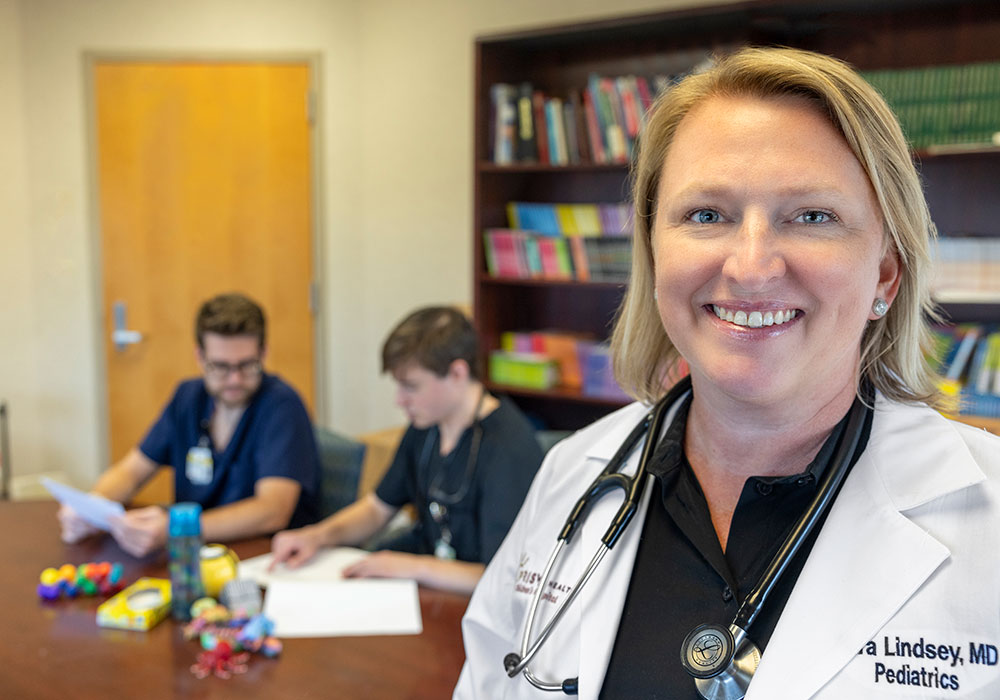Dr. Sara Lindsey thought for sure she’d work in adult medicine. But during her third year of medical school at the University of South Carolina, something clicked.
“I was like, ‘What am I doing? I absolutely want to be a pediatrician,’” she recalls with a laugh. “If you gave me an opportunity to hold a baby or play with children, I was all for that, and I still love that to this day.”
After completing her residency at Prisma Children’s Hospital and taking a clinical faculty position at the USC School of Medicine Columbia, she discovered something else she loved just as much as pediatrics: teaching it to aspiring physicians. In addition to the work she does in the classroom to educate preclinical first- and second-year students, Lindsey is assistant director of the pediatric clerkship, meaning she works closely with third-year as well as some fourth-year medical students during their clinical rotations at the children’s hospital. Her efforts have earned her USC’s 2024 Clinical Practice Teaching Award.
The School of Medicine’s pediatric rotation has a reputation for difficulty, but year after year, students repeatedly vote it their favorite. Much of that, says Lindsey, is due to the dedication of the pediatric department’s faculty, including clerkship director Dr. James Stallworth.
“It is a very organized and very hands-on clerkship,” Lindsey says. “We are big teachers. All of us who work here in the faculty put a lot of emphasis on teaching and being involved with students. And I think the students really appreciate that attention to learning and the availability of faculty.”
For some students, working alongside experienced doctors in clinical settings can be a little scary. Lindsey sees that learning curve as an opportunity for growth, and she encourages students to explore their curiosity instead of keeping quiet.
“I think a lot of students, especially on the clinical side, feel intimidated to ask questions because they feel like they’re supposed to know things,” she says. “But I always assure them that there are probably a number of other people who have the same question, and we all learn from questions. Even I learn when students ask me questions.”
We obviously learn medicine initially from a textbook, but clinical bedside teaching is important because it helps translate that book learning into action. So that may be anywhere from talking with patients and being able to listen to what they’re telling you, to examining them, to putting your hands on them and trying to figure out what’s going on. You’re putting the whole puzzle together from start to finish.
Lindsey has made hands-on learning experiences a central element of her teaching approach. Students who work with her in the simulation center get practice doing procedures such as lumbar punctures, intraosseous needles and intubations. Using mannequins designed to mimic patients, the students take on common pediatric cases and look for answers in their physical exam findings and vital sign changes.
“It allows the students to kind of put their hands on a patient and, from start to finish, kind of figure out what's going on with the patient, what do they need to do to manage it,” she says. “And it allows them to really have that experience in a safe environment before moving into being the one in charge and at the bedside.”
Being ready for the bedside is one of the reasons the first two years of medical school involve intensive classroom instruction. Students spend countless hours building a strong foundation in the basic sciences, including anatomy and physiology. During that time, they encounter Lindsey in the Intro to Clinical Medicine Class. From reading their textbooks and hearing from Lindsey and the other faculty members, students gain an idea of what they’ll see when they eventually begin treating real patients. The challenge for her clinical rotation students is applying those lessons.
“We obviously learn medicine initially from a textbook, but clinical bedside teaching is important because it helps translate that book learning into action,” she says. “So that may be anywhere from talking with patients and being able to listen to what they’re telling you, to examining them, to putting your hands on them and trying to figure out what’s going on. You’re putting the whole puzzle together from start to finish.”
Beyond teaching in the classroom and in the hospital, Lindsey makes time to guide her students in other ways. She advises the Pediatric Interest Group, where students learn more about the career through speakers, hands-on learning opportunities and volunteer work. She also mentors students at various points in their medical school journey, tailoring her advice to how far they are in the program.
“What a first-year needs is very different from what a fourth-year needs,” she says. “In the very beginning, I may be talking a lot more about, ‘Are you taking care of yourself? Are you getting enough sleep and how are you doing with your classes? Do you need academic support? It can even be building your CV and making sure you have all of those opportunities on your resume to help you be successful in your career. As they move to the clinical years, it’s ‘Have you chosen a specialty? How can you organize your schedule to optimize yourself for a successful residency application?’”
Some students decide to specialize in pediatrics. Some even do their residency at Prisma Children’s Hospital, meaning Lindsey gets to work alongside them after they graduate. Regardless of where their careers take them, the best part for Lindsey is seeing them discover what they love.
“Watching them progress and grow their knowledge base is really rewarding,” she says. “Every learner is different in where they start and maybe even where they end. But I think success is seeing a student progress through all four years and ultimately have a career that they’re interested in and happy with.”
